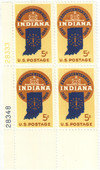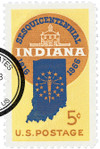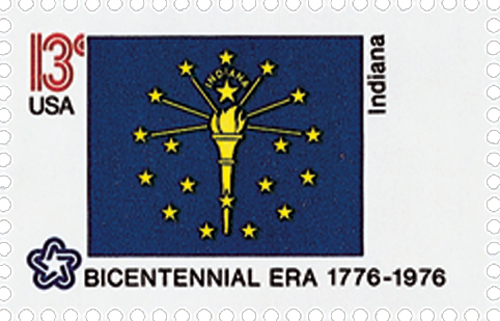
# 1308 - 1966 5c Indiana Statehood
5¢ Indiana Statehood
City: Corydon, IN
Quantity: 123,770,000
Printed By: Bureau of Engraving and Printing
Printing Method: Giori press
Perforations: 11
Color: Ocher, brown and violet blue
Indiana Becomes 19th U.S. State
On December 11, 1816, Indiana was admitted to the Union.
In 1679, the French explorer René-Robert Cavelier, the Sieur de La Salle, became the first European to explore Indiana. La Salle came to the area from French colonies in Canada in an effort to find a water route to the Pacific Ocean, traveling down the St. Joseph and Kankakee rivers. He returned in 1680, and explored the northern region of Indiana.
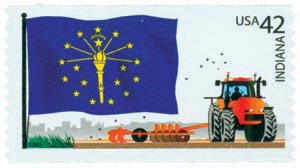
Soon after La Salle’s expeditions, French fur traders came to the area. They traded beads, blankets, knives, paint, and whiskey to the Indians in exchange for furs. These exchanges were quite lucrative for the French. During the 1720s, the French built fur trading posts to foster and protect the fur trade in Miami (near today’s Fort Wayne) and Ouiatenon (near today’s Lafayette). In 1732, the French created the first permanent European settlement in Indiana by building a fort at Vincennes.
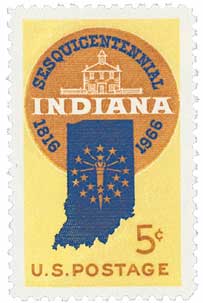
The British competed with the French for control of the fur trade. At first, the French were much more successful because they treated the Indians as equals. Over time, the British began to pay the Indians higher prices than the French. Plus, the British began trading firearms with them. The battle for control of the fur trade was one of the main factors in the French and Indian Wars. The British proved victorious in this conflict, and in 1763, France surrendered a great deal of its land claims, including Indiana, to the British.
Although British troops moved into Indiana following France’s surrender of this territory, Indiana settlers provided most of the region’s resistance against the Americans during the Revolutionary War. Virginia troops, under the leadership of George Rogers Clark, occupied Vincennes and its fort, Fort Sackville, in 1778. A British force recaptured the fort, but Clark took it again in 1779. Control of this area helped the American army dominate the Northwest.
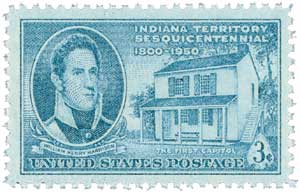
In 1787, Indiana became part of the Northwest Territory. At that time, settlers in the region were often attacked by Indians. A Miami chief, Little Turtle, led many strikes against the whites. In 1794, forces under General Anthony Wayne defeated a force of Miami Indians and other tribes at the Battle of Fallen Timbers, which took place near the modern city of Toledo, Ohio.
The U.S. Congress created the Indiana Territory in 1800. This included the modern states of Indiana, Illinois, and Wisconsin, as well as parts of Michigan and Minnesota. Vincennes was the capital of the territory. In 1809, Illinois became a separate territory, and at that time borders were nearly identical to present-day Indiana. That same year, the territory’s governor, future U.S. President William Henry Harrison, bought more than 2,500,000 acres of land from Indians in southern Indiana. The legendary Shawnee Chief Tecumseh claimed the purchase was unfair. He raised an army and purchased guns from the British. In 1811, Harrison defeated the Indians at the Battle of Tippecanoe. In 1813, Harrison again defeated Indian forces at the Battle of Thames, in which Tecumseh was killed. With this victory, the Americans were able to settle the land.
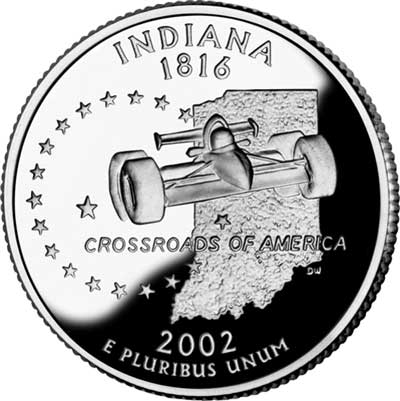
The earliest attempt at statehood came in 1811, when Jonathan Jennings submitted legislation to Congress. But the proposed territory only had 25,000 people, far fewer than was required to be made a state. The War of 1812 interrupted these attempts, but talks of statehood resumed in 1816. Then on December 11, 1816, Indiana achieved statehood. At first, the state was plagued by a lack of tax revenue. The only source of income for the state government was the land tax, and new settlers did not have to pay that for five years after buying their land from the Federal Government. Also, farmers made little or no profit on their crops, as transportation to the markets in the east was expensive and risky. In 1818, the Federal Government purchased land in the center of the state from the Indians. The New Purchase, as it was called, opened more land for settlement. The capital was moved to Indianapolis, where it has remained due to its central location.
5¢ Indiana Statehood
City: Corydon, IN
Quantity: 123,770,000
Printed By: Bureau of Engraving and Printing
Printing Method: Giori press
Perforations: 11
Color: Ocher, brown and violet blue
Indiana Becomes 19th U.S. State
On December 11, 1816, Indiana was admitted to the Union.
In 1679, the French explorer René-Robert Cavelier, the Sieur de La Salle, became the first European to explore Indiana. La Salle came to the area from French colonies in Canada in an effort to find a water route to the Pacific Ocean, traveling down the St. Joseph and Kankakee rivers. He returned in 1680, and explored the northern region of Indiana.

Soon after La Salle’s expeditions, French fur traders came to the area. They traded beads, blankets, knives, paint, and whiskey to the Indians in exchange for furs. These exchanges were quite lucrative for the French. During the 1720s, the French built fur trading posts to foster and protect the fur trade in Miami (near today’s Fort Wayne) and Ouiatenon (near today’s Lafayette). In 1732, the French created the first permanent European settlement in Indiana by building a fort at Vincennes.

The British competed with the French for control of the fur trade. At first, the French were much more successful because they treated the Indians as equals. Over time, the British began to pay the Indians higher prices than the French. Plus, the British began trading firearms with them. The battle for control of the fur trade was one of the main factors in the French and Indian Wars. The British proved victorious in this conflict, and in 1763, France surrendered a great deal of its land claims, including Indiana, to the British.
Although British troops moved into Indiana following France’s surrender of this territory, Indiana settlers provided most of the region’s resistance against the Americans during the Revolutionary War. Virginia troops, under the leadership of George Rogers Clark, occupied Vincennes and its fort, Fort Sackville, in 1778. A British force recaptured the fort, but Clark took it again in 1779. Control of this area helped the American army dominate the Northwest.

In 1787, Indiana became part of the Northwest Territory. At that time, settlers in the region were often attacked by Indians. A Miami chief, Little Turtle, led many strikes against the whites. In 1794, forces under General Anthony Wayne defeated a force of Miami Indians and other tribes at the Battle of Fallen Timbers, which took place near the modern city of Toledo, Ohio.
The U.S. Congress created the Indiana Territory in 1800. This included the modern states of Indiana, Illinois, and Wisconsin, as well as parts of Michigan and Minnesota. Vincennes was the capital of the territory. In 1809, Illinois became a separate territory, and at that time borders were nearly identical to present-day Indiana. That same year, the territory’s governor, future U.S. President William Henry Harrison, bought more than 2,500,000 acres of land from Indians in southern Indiana. The legendary Shawnee Chief Tecumseh claimed the purchase was unfair. He raised an army and purchased guns from the British. In 1811, Harrison defeated the Indians at the Battle of Tippecanoe. In 1813, Harrison again defeated Indian forces at the Battle of Thames, in which Tecumseh was killed. With this victory, the Americans were able to settle the land.

The earliest attempt at statehood came in 1811, when Jonathan Jennings submitted legislation to Congress. But the proposed territory only had 25,000 people, far fewer than was required to be made a state. The War of 1812 interrupted these attempts, but talks of statehood resumed in 1816. Then on December 11, 1816, Indiana achieved statehood. At first, the state was plagued by a lack of tax revenue. The only source of income for the state government was the land tax, and new settlers did not have to pay that for five years after buying their land from the Federal Government. Also, farmers made little or no profit on their crops, as transportation to the markets in the east was expensive and risky. In 1818, the Federal Government purchased land in the center of the state from the Indians. The New Purchase, as it was called, opened more land for settlement. The capital was moved to Indianapolis, where it has remained due to its central location.





